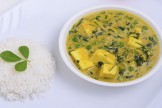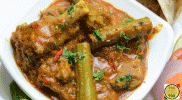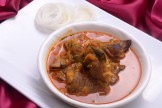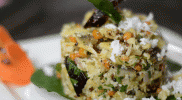
Malai Methi Matar Paneer tastes amazingly delicious with the richness of milk, cream, pan...

Afrodisiac drumsticks and mutton curry is a relish mutton curry which is cooked in combi...
This is a non vegetarian snack recipe. The chicken bread is one of favourite braided and ...

Aatukal curry is made of lamb or goat's leg often referred to people having a cold or flu...

Valakkai Podimas or Plantain podimas is a very simple and healthy recipe prepared with ra...

Aloo Posto is one of the popular recipes in West Bengal.You can have it with hot steamed ...
Burned brinjal pachi pulusu is a classic Andhra dish prepared with tamarind juice, burned brinjal and green chilies.
Rasam is usually made from tomatoes and spices like pepper powder etc. The flavor of rasam is spicy, sour and yummy. Rasam can be made with Rasam powder which includes approximately a similar spice as Sambhar powder, slightly extra coriander powder. Rasam goes perfectly with rice or you may even drink just like a soup if you find yourself suffering from cold. Rasam can also be well-known as thakkali rasam, chaaru, saaru an... Read More..
About Recipe
Vankaya Sannvankaya pulusu, Kathirikai kulambu, Begun thok |
|||||||||||||||||||||||||||||||||||||||||
|
|||||||||||||||||||||||||||||||||||||||||
Rasam is usually made from tomatoes and spices like pepper powder etc. The flavor of rasam is spicy, sour and yummy. Rasam can be made with Rasam powder which includes approximately a similar spice as Sambhar powder, slightly extra coriander powder. Rasam goes perfectly with rice or you may even drink just like a soup if you find yourself suffering from cold. Rasam can also be well-known as thakkali rasam, chaaru, saaru and kabir. It is among the certain recipe in Kerala.
Rasam can be made without having dal, or with a little bit of dal - 1 tsp. into a 1 / 2 cup. Usually, toor dal is used, and contains this is similar to Sambar. It's a thin, spicy soup generally made with the addition of tomatoes. It hardly ever contains other vegetables. The best style is made from just water and spices.
There are several varieties of Rasam. Of those, some are made to be used when having a fever and/ or even a cold while others are offered with a regular meal or festive meals known as “Sadhyas”. While in the plan for being offered in a festive meal, a Rasam is offered with rice and papads following the sambhar and rice prior to the payasam (kheer).

ARUNA SINGH Posted on Mon Dec 14 2015
Iam a Banglorean.....n dis is eaten with mudde(ragi ball). tks!?
Reply 0 - Replies
 Easy recipes
Easy recipes
 Healthy Recipes
Healthy Recipes
 Dessert Recipes
Dessert Recipes
 Mutton and Lamb
Mutton and Lamb  Indian Bread Recipes
Indian Bread Recipes
 Dal Recipes
Dal Recipes
 Chutney and Pickles
Chutney and Pickles  Indo-Chinese Recipes
Indo-Chinese Recipes
 Snacks and Appetizers
Snacks and Appetizers
 Low Fat Recipes
Low Fat Recipes
 Chaat Recipes
Chaat Recipes
 Biryani and Rice
Biryani and Rice  Curry Recipes
Curry Recipes
 Indian Sweet Recipes
Indian Sweet Recipes
 Egg Recipes
Egg Recipes
 Paneer Recipes
Paneer Recipes
 Chicken Recipes
Chicken Recipes
 Indian tiffins
Indian tiffins
 Egg less Recipes
Egg less Recipes
 Soups and Salads
Soups and Salads
 Indian Sea Food
Indian Sea Food
 Manchurian Recipes
Manchurian Recipes
 Indian Drinks Recipes
Indian Drinks Recipes
 Dinner Recipes
Dinner Recipes
asha pranuthi Posted on Sun Dec 13 2015
very nice nd can we use eggplant instead of that???
Reply 0 - Replies